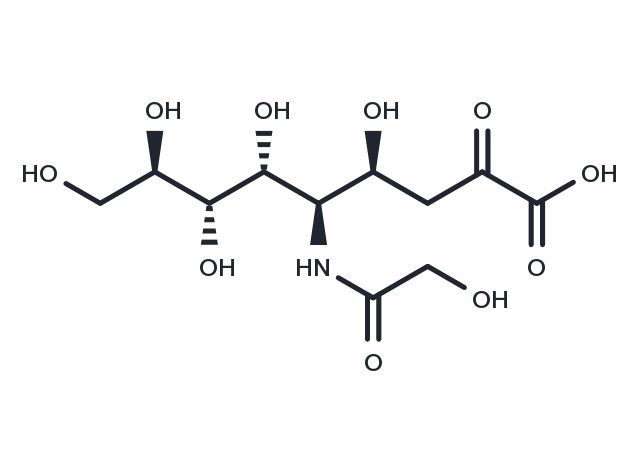Powder: -20°C for 3 years | In solvent: -80°C for 1 year


N-Glycolylneuraminic acid (GcNeu) is a nonhuman sialic acid molecule synthesized in pigs. N-Glycolylneuraminic acid is a receptor of human and animal IAVs.

| Pack Size | Availability | Price/USD | Quantity |
|---|---|---|---|
| 1 mg | In stock | $ 44.00 | |
| 2 mg | In stock | $ 63.00 | |
| 5 mg | In stock | $ 97.00 | |
| 10 mg | In stock | $ 163.00 | |
| 25 mg | In stock | $ 278.00 | |
| 50 mg | In stock | $ 428.00 | |
| 100 mg | In stock | $ 623.00 | |
| 1 mL * 10 mM (in DMSO) | In stock | $ 116.00 |

| Description | N-Glycolylneuraminic acid (GcNeu) is a nonhuman sialic acid molecule synthesized in pigs. N-Glycolylneuraminic acid is a receptor of human and animal IAVs. |
| In vitro | Expression of N-Glycolylneuraminic acid on human cells clearly suppressed infectivity of IAVs that possess N-Glycolylneuraminic acid binding ability. Furthermore, there was no difference in infectivity of a transfectant virus that included the wild-type HA gene from A/Memphis/1/1971 (H3N2), which shows no N-Glycolylneuraminic acid binding, between parent MCF7 cells and cells stably expressing the monkey CMAH gene (CMAH-MCF7 cells). On the other hand, cell entry of the transfectant virus that included the N-Glycolylneuraminic acid-binding HA gene with a single mutation to Tyr at position Thr155 was arrested at the stage of internalization from the plasma membrane of the CMAH-MCF7 cells[1]. |
| Synonyms | NeuGc, GcNeu |
| Molecular Weight | 325.27 |
| Formula | C11H19NO10 |
| CAS No. | 1113-83-3 |
Powder: -20°C for 3 years | In solvent: -80°C for 1 year
DMSO: 76 mg/mL (233.65 mM)
You can also refer to dose conversion for different animals. More
bottom
Please see Inhibitor Handling Instructions for more frequently ask questions. Topics include: how to prepare stock solutions, how to store products, and cautions on cell-based assays & animal experiments, etc.
N-Glycolylneuraminic acid 1113-83-3 Metabolism Microbiology/Virology Influenza Virus Endogenous Metabolite NeuGc Inhibitor NGlycolylneuraminic acid inhibit N Glycolylneuraminic acid GcNeu inhibitor
